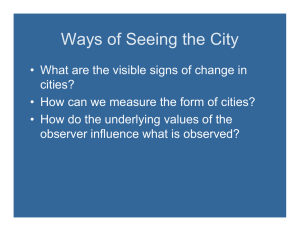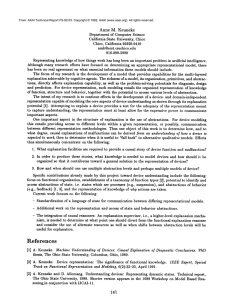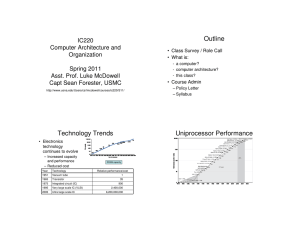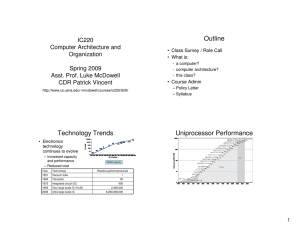The Hunt for Right Abstractions Keshav Pingali
advertisement
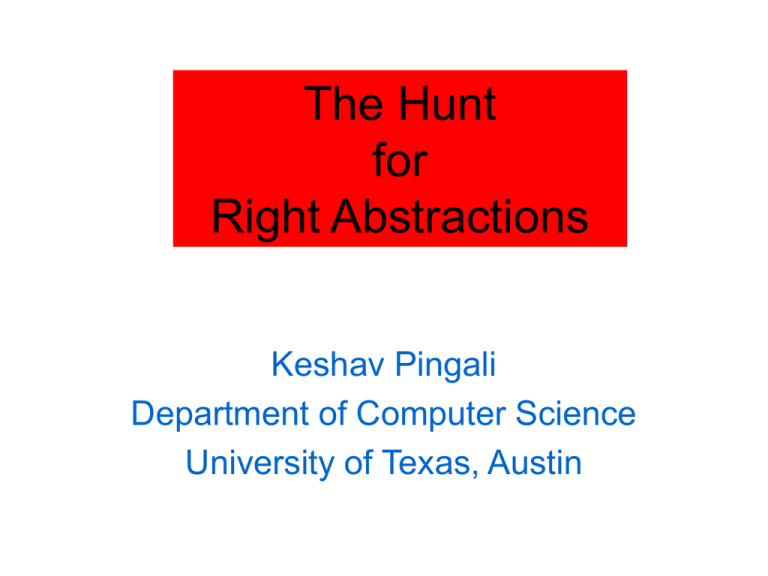
The Hunt for Right Abstractions Keshav Pingali Department of Computer Science University of Texas, Austin Dewar’s profile • Bachelor of Technology (1978) – I.I.T.Kanpur • S.M. / E.E./Sc.D. (1983,1986) – M.I.T., Cambridge, MA • Faculty member at Cornell University (1986-2006) – Department of Computer Science – Department of Electrical and Computer Engineering • Faculty member at UT, Austin (2006-) – Department of Computer Science – Director, Center for Grid and Distributed Computing, Institute for Computational Engineering and Sciences (ICES) • Favorite hobby – writing newspaper columns on current political events • Favorite beer – Corona • Favorite quote – “Everything should be as simple as possible, but not any simpler.” Einstein High-level theme of talk • My definitions: – PL design: • finding abstractions to express algorithms – PL implementation research: • finding out if these are good abstractions • Questions: – What are abstractions? – Why are abstractions useful? – What does abstraction have to do with programming languages? – What are good abstractions in the context of programming languages? The Power of Abstraction • Bridges of Konigsberg – town in Prussia – now named Kaliningrad in Russia • Problem: – Is there a walk that crosses each bridge exactly once? • Citizens of Konigsberg in the 17th and 18th centuries tried to solve this problem Solution by Euler • Key insight: connectivity between land masses is what is important, not the actual distances or the orientations of the bridges • Create an abstraction: graph – One node for each land mass – Edge between two nodes if there is a bridge connecting the two land masses • Graph has nodes of odd degree, so there is no walk with desired property • Led to field we now call topology Abstraction • Definition: – the act or process of leaving out of consideration one or more properties of a complex object so as to focus on others • (e.g.) Euler left out distances and orientations – a general concept formed by extracting common features from specific examples • (e.g.) general concept of “graph” allows you to solve similar problems Bridges of Madison County (Iowa) Bad abstractions • Abstraction is bad if it has thrown away some essential feature of the problem – topologist is someone who does not know the difference between a doughnut and coffee-cup “Naked Blue IV” Henri Matisse (1952) • What is essential depends on the use you intend to make of the abstraction Abstractions in PL • My opinion: most important advances in PL have introduced new abstractions • Examples: – Procedures (1950?) • abstraction: parameterized code module (l-abstraction) • abstracted away: implementation code – Processor architecture (IBM 360) • abstraction: machine language • abstracted away: implementation of machine language – FORTRAN I (1957) • abstraction: high-level programming language • abstracted away: machine language Abstractions in PL (contd.) • Examples (contd.): – Structured programming (1967) • abstraction: structured control-flow constructs like if-thenelse, while-loops, for-loops etc. • abstracted away: conditional jumps (machine language relic) – Object-oriented programming (1970-) • abstraction: abstract data type • abstracted away: representation of data type – Automatic storage management (1960-) • abstraction: objects • abstracted away: machine addresses (pointers) Bad abstractions in PL? • Abstractions that are – difficult to reason about – hard to implement efficiently • Example: functional languages for parallel programming – Abstract away the notion of storage: only values and functions on values – Elegant parallel execution models: reduction, dataflow – Big problem: data structure manipulation can be very inefficient if you view data structures as values – Unfortunately, parallelism in algorithms is mostly data parallelism – Notion of storage might be an essential feature of program execution that should not be abstracted away by the programming language • Caveat: functional languages are perfectly good abstractions for other uses – Semantics of programming languages Recap • My views: – PL design: • finding abstractions to express algorithms – PL implementation research: • finding out if these are good abstractions • OK, so how do you get started in PL implementation research? Getting started • Take relevant courses – Modern compiler design • there is lots more to compilers than the Dragon book • you will learn powerful algorithms and mechanisms for implementing abstractions – Algorithms – Machine learning • used increasingly in PL implementation – Statistics and inference • learn good experimental protocols • we do not do enough of this in Computer Science • Read papers from major PL conferences – PLDI: Programming Language Design and Implementation – POPL: Principles of Programming Languages – OOPSLA: Object-oriented Programming Systems, Languages and Architectures – ASPLOS: Architectural Support for Programming Languages and Operating Systems – PPoPP: Principles and Practice of Parallel Programming • Try to replicate results from papers that interest you – standard apprenticeship technique in other sciences – we do not do enough of this in Computer Science – don’t hesitate to contact authors if something is not clear or you cannot replicate their results (but be polite) • Build on other people’s software – starting from scratch is too time-consuming – not even feasible for most research projects nowadays – always be on the look-out for tools and systems you can steal (Open64 compiler from Intel, Java compilers and JVMs like Jikes,…) • Do NOT try to tweak other people’s heuristics in minor ways – Most problems in PL implementation are NP-complete or undecidable at some level of generality – Heuristics are the name of the game – Not difficult to add bells and whistles to other people’s heuristics • You go breadth-first, I go depth-first • Bulk of papers in conferences are of this nature – Life is too short to play second fiddle • The scenery never changes if you are not the lead husky. • Hunt for abstractions – write lots of code and think about what might simplify your job – talk to lots of people who write lots of code and think about what might simplify their job • Implementing abstractions is critical – only way to determine if an abstraction is right – use your prototype and give it to your friends to use • Encourage and learn from feedback – Few abstractions are perfect the first time around The Hunt For Right Abstractions
